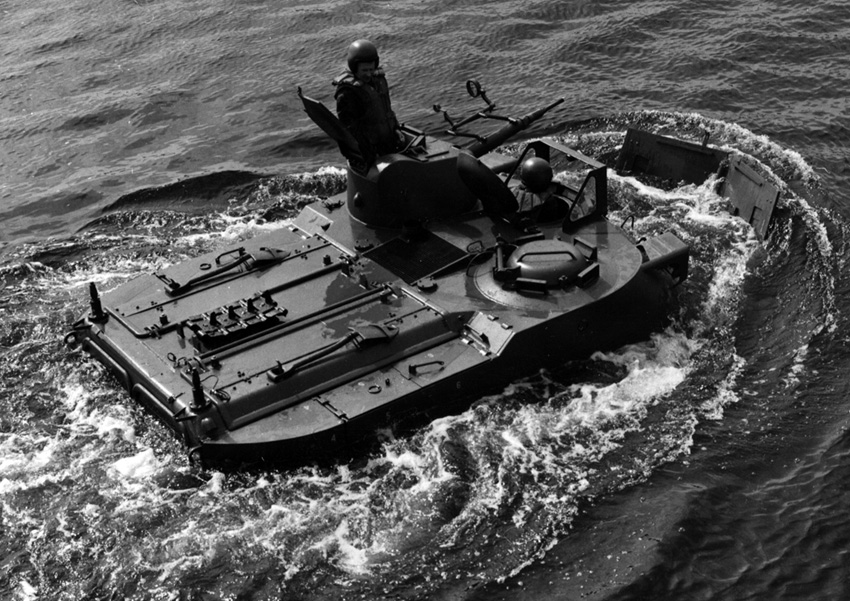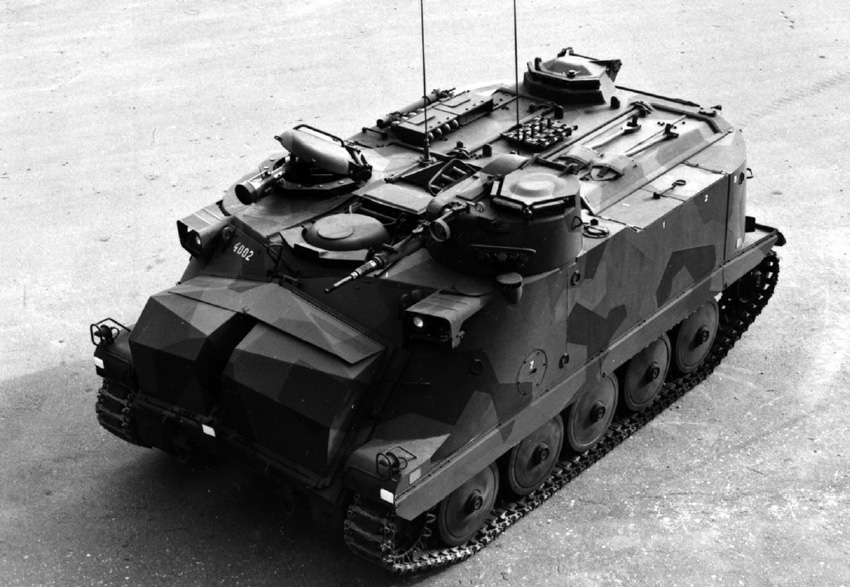Armored personnel carriers of the Pansarbandvagn 302 family (pbv 302) have been in service with the Swedish army since 1960 and have been used in all mechanized units as the main vehicle.
As part of the 16th military assistance package announced by the Swedish government, the country will transfer all pbv 302 armored personnel carriers to the Defense Forces of Ukraine. This transfer will enhance the capabilities of the units and provide the means to protect infantry in battle.
History of appearance
The arrival of Pansarbandvagn 302 (pbv 302) infantry fighting vehicles was relatively unexpected from the start. As part of the Swedish Army’s reforms in 1960, most infantry units were to become mechanized and transition from trucks to armored tracked vehicles. Initially, the Swedish army ordered the Pansarbandvagn 301 (pbv 301) infantry fighting vehicle, which was created on the basis of tanks. Armored personnel carriers were not produced from scratch, but used the already decommissioned chassis, which was then upgraded to accommodate the landing.

Having received feedback during the operation of these armored personnel carriers, the Swedish Defence Materiel Administration, together with the Swedish Ministry of Defense, began to form a new technical assignment for the development of a new vehicle from scratch.
The new terms of reference included the following items:
- The vehicle must transport infantry under the cover of its own armament between different points on the battlefield, with at least the same maneuverability as the new Strv 103 tank;
- The crew must be able to fight from within the vehicle;
- Its weapons should provide effective combat against enemy infantry, armored vehicles, and slow aircraft;
- The combat vehicle should be able to float without additional equipment.
In addition to domestic manufacturers, a request for new armored personnel carriers was sent to the UK, France, Austria, West Germany, the Soviet Union, the USA and Canada. During the evaluation of armored personnel carriers, the Ministry of Defence ultimately chose the American M113 and a promising project from the Swedish company Hägglunds.
The tests of the M113 did not satisfy the Swedes, as the vehicle was expensive to manufacture, had weak defensive weapons, and featured a ramp that was not very suitable for exiting the vehicle while in motion or for operating with an open squad compartment.

Despite the rejection of the M113, Swedish experts have gained valuable experience that was later implemented in the development of the pbv 302 APC.
In late 1961, Hägglund and Söner were awarded a contract to develop a new full-length APC. The first of two prototypes was completed in December 1961, the second in December 1962, and in October 1963, the company received a contract for the initial production of 700 Pansarbandvagn 302 APCs.

Serial production began on the facilities of Hägglund and Söner companies in the city of Ernskeldsvik in 1965, and in February 1966, the Swedish army received the first batch of Pansarbandvagn 302. The production continued until December 1971. The development cost was SEK 2.8 million at that time, and the cost of one armored personnel carrier was SEK 233,000. Such low cost was achieved by using fully developed subsystems from the civilian market (engine and gearbox), as well as parts manufactured in large quantities for foreign light combat vehicles (mainly undercarriage units).
Technical specifications
The armored personnel carrier was made of fully welded steel armor, which reached a thickness of 23 mm. This provided protection against infantry small arms and low-power guns up to 20 mm caliber. In addition, this provided the vehicle with better protection compared to the common M113 and FV432 armored personnel carriers.

This design of the sides provided the squad compartment with additional ballistic protection and the vehicle with additional buoyancy. With a payload of up to 1200 kg, the vehicle could remain buoyant. If it exceeded this weight, its amphibious capabilities were compromised. To navigate, the armored personnel carrier had to be prepared by launching a pump to pump out water and opening the frontal breakwater. The vehicle was propelled on water by its tracks.

The vehicle used a Volvo PENTA THD 270 hp engine as well as a Volvo PENTA R-60 gearbox (8+2 gears). The fuel consumption was about 9-10 liters/km during a regular drive, and the maximum speed was 66 km/h. Later, Volvo started using both the engine and the gearbox in its buses. This ensured the high availability of spare parts and the mass of the necessary elements.

The squad compartment could accommodate eight soldiers, with four facing each other on both sides. The top was hinged, allowing them to fire towards the enemy without leaving the fighting vehicle. Despite its capabilities, the pbv 302 did not include a system for protection against weapons of mass destruction or special equipment for driving and shooting at night.
According to the technical task, the armored personnel carrier was armed with 20mm guns, which were repurposed from the J29 Tunnan fighters to save costs. These guns were upgraded for use in the APC’s turret. The gun could fire single rounds or in automatic mode, with a rate of fire of 8-9 rounds per second. The ammunition capacity of the gun when using magazine power was 300 shells with 30-shell magazines, or only 10 pieces. When using belted feed, the gun could accommodate 135 shells.

Targeting was manual, and the turn speed was adjustable. The turret could rotate 360°, and the gun could be lowered -10° or raised +50°.
Modernization within the REMO program and for peacekeeping units
Under the REMO program, the modernization and repair of vehicles occurred between 1984 and 1997. The vehicles received a more reliable gun power store for 30 shells, and the driver’s and gunner’s seats were replaced to improve comfort. Additionally, upgrades included the installation of a water heater, a modern satellite telephone system, a satellite positioning system, and a laser rangefinder in place of the commander.

The modernization was primarily aimed at inexpensive improvements to the combat vehicle’s interior environment and the overall positioning system of the military units. Additional enhancements included extra view slits, an aft hatch, and new seats. There was also an improvement in the driving qualities on water, achieved by increasing the breakwater to limit water ingress into the hatches and gun turret, enabling more efficient firing while afloat.
Furthermore, it’s noteworthy that about 50 armored personnel carriers were modernized for use by Swedish UN units in Bosnia. These vehicles received additional protection and special Kevlar insertions for better interior protection.

Transfer and use in Ukraine
As part of the 16th military assistance package from the Swedish government, the country will transfer all remaining armored personnel carriers, which were withdrawn from the Swedish army in 2014. In total, about 300 pbv 302 armored personnel carriers are on the balance sheet of the Swedish Ministry of Defense. After modernization and repair, these vehicles will be transferred to Ukraine.
Although the vehicle was originally developed as an armored personnel carrier, it can fulfill the role of an infantry fighting vehicle in the Ukrainian Defense Forces, given its suitable driving characteristics, gun weapons, and robust armor.
In addition, their transfer will improve the mobility of the Ukrainian troops, including newly created brigades, and provide infantry with high-quality transport that is capable of combating enemy light equipment.
Recently, Militarnyi reported on how soldiers of the 503rd Marine Battalion held a bridgehead near Krynky and attempted to cross the river. As noted by one of the military personnel, vehicles that used the rotation of tracks to move in water performed better than the Soviet BMP-3, which relies on water jets for propulsion.
“BMP-3 unlike the Swedish armored personnel carrier “BvS” uses water jets, not tracks, to move through the water. Because of this, during the movement, it passed 100 meters, after which it was stuck in a mule and returned back,” said the military officer from 502nd Battalion.
In such circumstances, the pbv 302 would be highly suitable for Ukrainian marines to ensure the smooth passage of rivers and the delivery of ammunition, as well as personnel.
It’s also noteworthy that spare parts are readily available, as they are commonly found in the civilian market. The Swedish army specifically sought a vehicle with affordable civilian components and spare parts.
SUPPORT MILITARNYI
Even a single donation or a $1 subscription will help us contnue working and developing. Fund independent military media and have access to credible information.


 Андрій Тарасенко
Андрій Тарасенко 
 Юрій Юзич
Юрій Юзич 
 Віктор Шолудько
Віктор Шолудько 
 Роман Приходько
Роман Приходько 

 Андрій Харук
Андрій Харук 


 Yann
Yann 
 СПЖ "Водограй"
СПЖ "Водограй" 

 ГО "Військова школа "Боривітер"
ГО "Військова школа "Боривітер" 



